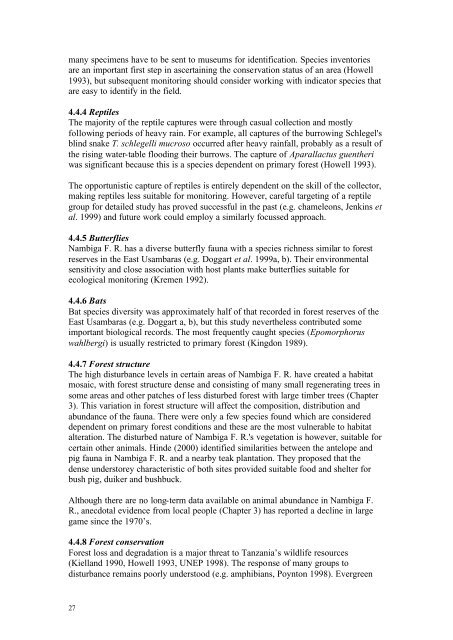Frontier Tanzania Savanna Research Programme
Frontier Tanzania Savanna Research Programme
Frontier Tanzania Savanna Research Programme
You also want an ePaper? Increase the reach of your titles
YUMPU automatically turns print PDFs into web optimized ePapers that Google loves.
many specimens have to be sent to museums for identification. Species inventoriesare an important first step in ascertaining the conservation status of an area (Howell1993), but subsequent monitoring should consider working with indicator species thatare easy to identify in the field.4.4.4 ReptilesThe majority of the reptile captures were through casual collection and mostlyfollowing periods of heavy rain. For example, all captures of the burrowing Schlegel'sblind snake T. schlegelli mucroso occurred after heavy rainfall, probably as a result ofthe rising water-table flooding their burrows. The capture of Aparallactus guentheriwas significant because this is a species dependent on primary forest (Howell 1993).The opportunistic capture of reptiles is entirely dependent on the skill of the collector,making reptiles less suitable for monitoring. However, careful targeting of a reptilegroup for detailed study has proved successful in the past (e.g. chameleons, Jenkins etal. 1999) and future work could employ a similarly focussed approach.4.4.5 ButterfliesNambiga F. R. has a diverse butterfly fauna with a species richness similar to forestreserves in the East Usambaras (e.g. Doggart et al. 1999a, b). Their environmentalsensitivity and close association with host plants make butterflies suitable forecological monitoring (Kremen 1992).4.4.6 BatsBat species diversity was approximately half of that recorded in forest reserves of theEast Usambaras (e.g. Doggart a, b), but this study nevertheless contributed someimportant biological records. The most frequently caught species (Epomorphoruswahlbergi) is usually restricted to primary forest (Kingdon 1989).4.4.7 Forest structureThe high disturbance levels in certain areas of Nambiga F. R. have created a habitatmosaic, with forest structure dense and consisting of many small regenerating trees insome areas and other patches of less disturbed forest with large timber trees (Chapter3). This variation in forest structure will affect the composition, distribution andabundance of the fauna. There were only a few species found which are considereddependent on primary forest conditions and these are the most vulnerable to habitatalteration. The disturbed nature of Nambiga F. R.'s vegetation is however, suitable forcertain other animals. Hinde (2000) identified similarities between the antelope andpig fauna in Nambiga F. R. and a nearby teak plantation. They proposed that thedense understorey characteristic of both sites provided suitable food and shelter forbush pig, duiker and bushbuck.Although there are no long-term data available on animal abundance in Nambiga F.R., anecdotal evidence from local people (Chapter 3) has reported a decline in largegame since the 1970’s.4.4.8 Forest conservationForest loss and degradation is a major threat to <strong>Tanzania</strong>’s wildlife resources(Kielland 1990, Howell 1993, UNEP 1998). The response of many groups todisturbance remains poorly understood (e.g. amphibians, Poynton 1998). Evergreen27
















